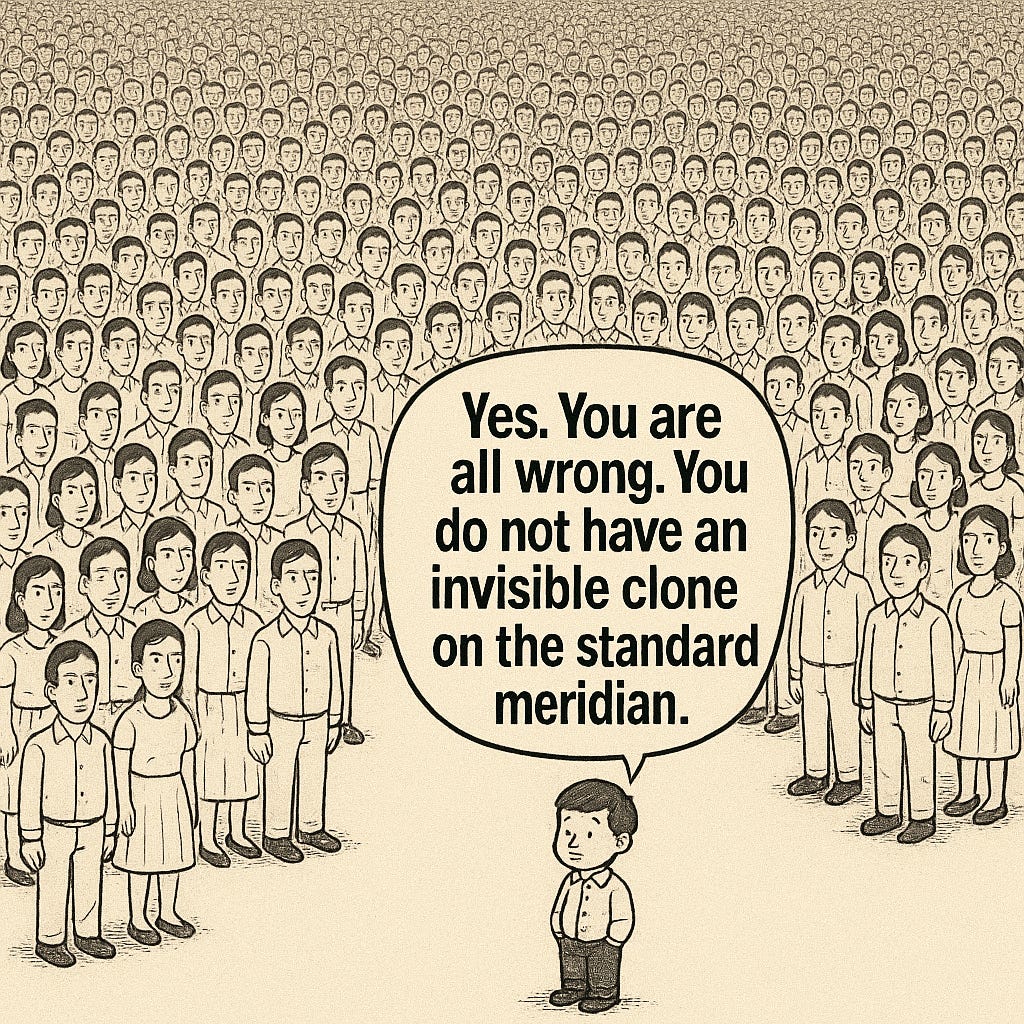Two Methods of Planetary Calculation:
Fantasy vs. the Actual Sky
1) All astrological programs adhere to the post-1883 formula (CT = UT1 - TZ offset) in the calculation of planets via synchronizing clocks to a time zone’s standard meridian (e.g., 120°W for PST). This “2+2=5” approximation formula assumes observers are “clones” on the standard meridian, ignoring their actual longitude. Only observers on the standard meridian have clocks set to their local mean time (LMT), as shown in the pre-1883 formula: LMT = UT1 - longitude (Explanatory Supplement, 1961, p. 74, https://archive.org/details/astronomicalalmanac1961/page/n83/mode/2up). For others, the post-1883 formula dishonors their location, calculating planets as if they’re at the TZ meridian’s longitude. House cusps use the observer’s actual longitude via local apparent sidereal time (LAST), but the insidious post-1883 formula (CT = UT1 - TZ offset) assumes the observer is elsewhere - an invisible clone on the standard meridian.
2) Used by few astrologers (e.g., via Walter Pullen’s Astrolog/w macro), this method aligns with the rotational definitions of sidereal time and universal time (UT1, formerly GMT). Sidereal time is universally treated as rotational - no two observers on different meridians share the same LAST (house structure). Until November 18, 1883, astrologers treated GMT (now UT1) as rotational, using the equation: LMT = UT1 - longitude. The U.S. Congress then mandated clock synchronization to time zone meridians, creating a “legal timeline” where only meridian observers reflect this relationship (Explanatory Supplement, 1992, p. 50, https://archive.org/details/explanatorysuppl00pken/page/50/mode/2up). Post-1883, astrologers adopted a “global now” myth, treating UT1 as a homogeneous “same everywhere” moment (https://en.wikipedia.org/wiki/Universal_Time), ignoring its definition as Greenwich’s LMT. Proponents (we won't name them) defend this with absurd “Superman antics” or phone call tricks, claiming time is uniform. It’s not - it’s a “semi-global now” within time zones, with no 24-hour global time zone to justify their fantasy.
The standard method calculates the Moon as if it’s the same for all observers within the time zone. They are instructed that they have invisible clones on the TZ meridian, which longitude is used for their Moon calculation. This is not only pure fantasy but a dishonoring of their physical location and true orientation to the sky! The way out of this 142 yr. old-rabbit-hole entrapment is to acknowledge and honor the observer's longitude via the LMT variation in the calculation of the planets. This is done with the formula that converts CT to UT1 and vice versa:
For longitudes west of Greenwich:
1 - standard time = universal time - time-zone offset - LMT variation
or the equivalent: CT = UT1 - ΔT_zone - [(λ_obs - λ_std) × 4 / 60]
2 - universal time = standard time + time-zone offset + LMT variation
or the equivalent: UT1 = CT + ΔT_zone + [(λ_obs - λ_std) × 4 / 60]
For longitudes east of Greenwich:
1 - standard time = universal time + time-zone offset - LMT variation
or the equivalent: CT = UT1 + ΔT_zone - [(λ_obs - λ_std) × 4 / 60]
2 - universal time = standard time - time-zone offset + LMT variation
or the equivalent: UT1 = CT - ΔT_zone + [(λ_obs - λ_std) × 4 / 60]
… where the LMT variation is the distance in time east from the standard meridian, CT = civil or standard time, and UT1 = GMT or the LMT of Greenwich, a longitude- and observer-dependent calculation.
This method yields a “local apparent UT1 (LAUT1)” (for lack of a better term), ensuring accurate local event timing, unlike clone-based transit reports. For example, at 4:00 am PST, clock synchronized to 120°W, the Moon is at 0° Aqu 39'40" for observers on that meridian. At 116°15'W, it’s 0° Aqu 48'07"; at 108°45'W, 1° Aqu 05'04"; at 105°W, 1° Aqu 13'32". The synchronization of clocks elsewhere within the time zone does NOT synchronize the LMTs of other observers. They still experience their actual LMT and the complementary orientation to the sky where they are, e.g., a later Moon if to the east, earlier if to the west, of the time zone meridian. The Moon doesn't freeze in the sky due to the willy-nilly synchronization of clocks.
This (4:00 am PST) is NOT the synchronized clock time of the other observers at 105°W who saw the same Moon an hour earlier. They saw it when the observers at 120°W saw it, and observer #5 who has his clock synchronized to the 120°W meridian is experiencing Cosmic time (UT1) later as well (see Astrolog chart) with the Moon at 5° Aqu 11'09" at 4:00 am PST on his clock. The other Greenwich observers, with their clocks set eight hours later than his, saw the same Moon as all the other observers on Earth who had their clocks synchronized to their respective TZ meridians and were located there.
The rule of thumb: If clocks are synchronized to a time zone meridian (e.g., 4:00 am PST), observers to the east of it have a UT1 LATER (with of course a later Moon position) and those to the west an EARLIER UT1 (earlier Moon position). Clock synchronization doesn’t merge LMTs - observers see their actual sky.
If any “Master astrologer,” astrophysicist, or programmer defends this synchronization hoax, tell him or her: “You are perpetuating a blatant falsehood! Abandon this 142-year-old fantasy/hoax or lose all integrity.”
We invite astrologers, developers, and enthusiasts to sign our petition (https://chng.it/LYjn7RqgDn) and advocate for accuracy and precision instead of the ridiculous clone theory.
______________________
Astrolog chart for Obs. 5






